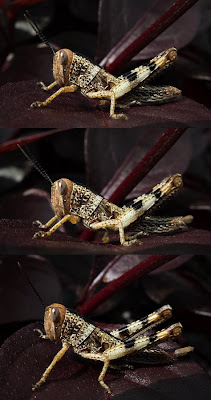White disc on white car with white house in background | Fuji X10 | Herston, December 19, 2011
I have confession to make. In the past I ignored the white discs, or orbs in my photos. The photo on the top illustrates my blindness. Discovery of the orbs in the photo above had provoked me on detailed examination of all my images taken in orb-prone conditions. I went for "orb hunting" in my photos. It turned out that some of my photos from Fuji X10 do have the orbs that were escaped my attention earlier. Moreover, I also identified the white discs in my photos taken with Olympus E-30 in 2010(!). Mind you, these white discs are smaller than famous orbs from the Fuji X10 but they are 1) white 2) round 3) have sharp border (see the 100% crop below). And I have not noticed these white discs. Isn't it strange? This need to be explained.
Three black cars at Drunken Admiral | Olympus E-30 | Hobart, September 2010
100% crop from the original image
My first explanation was quite simple. At that time (2010) the orbs were not part of my
tonal, so it was nearly impossible for me to identify these white discs as orbs. In other words, where I see a grass, a botanist would identify many different species with distinct names in Latin. It is hard to see something without
prior knowledge. But that was very simple explanation, and while I like Castaneda's books, I don't like the explanation because it means that I do not pay attention to small details in my photos.
Next I came with a conspiracy theory that explains everything about orbs. Let's look into the real facts. First, apparently there are quite a few small white discs, or "baby orbs" in my early photos taken with Olympus E-30. Second, I was doomed to buy Fuji X10 since I saw pictures of the Fuji X10 and read the spec of the camera. It felt as a camera I want to have all my life despite the fact that I newer used any Fuji camera. I bought it as soon it became available in Australia. So, the orbs in my photos became bigger but I was in the state of orb-denial and made a lot pictures with the Fuji X10. And these images sometimes have big orbs...
I can explain this bizarre situation. Imagine that the orbs are living creatures, extraterrestrials that can control our brains. Yes, I watched They Live, and I like this movie. But this theory does explain everything. The small "baby orbs" from Olympus E-30 convinced my to buy Fuji X10, the famous orb-generator. I am blindfolded by these orbs and take so many pictures with the X10, just to increase the number of orbs on the planet. I skip my lunch and go out to take picture with this camera. Instead of consuming calories myself I facilitate propagation of the orbs Look, there are people who bought the X10 being fully aware about the orbs issue. Guess what? They also increase amount of orbs. While these people may come with different explanations why they bought such camera, it might be just a mask. I suspect all Fuji X10 owners are controlled by the orbs. They also post images with the orbs on the web, and the orbs spread through the web as a forest fire conquering brains and consciousness of new people.
#############################################
PS
I had terrible week working 12 hours a day, so don't take it too seriously.
PSS
White discs or disks? It seems that people on the dpreview forum use both.


















